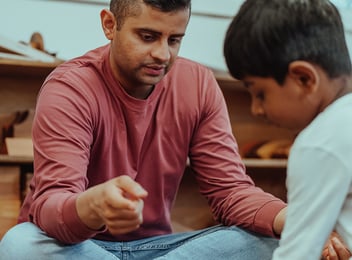ECMS’ approach to place-based teaching and learning, by its nature, feels different at each service. What does it mean in the day to day life of a service to take a place-based approach? At the Merrell Kindergarten, Nominated Supervisor Rebecca Waingold and her team see it as a way of being constantly aware and respectful of their surroundings, and encouraging their learners to share this awareness. They have a great garden at The Merrell and they consider place when they ask themselves “What are we planting? Why are we planting? What will the children learn from that? And how is it relevant to us here?”
Any conversation about surroundings must start with contemplation of whose Country we’re on. The team wanted to display some calendars featuring beautiful Aboriginal artworks at the service, but they wanted to go further than that. They found out who the artist was and emailed her to ask permission. The artist, Loretta Egan, appreciated their respectful approach and from there an ongoing relationship between Loretta and the service began. The service purchased one of her prints, Family Tree, and it’s displayed in the foyer with an acknowledgement of her consent and her photograph and bio. So the children know who Loretta is and that they are honoring her in seeking her permission to display her work.
They have sought Loretta’s advice on other matters too. For instance, Rebecca was unsure about the appropriate way to refer to Loretta’s people: should they use the term Indigenous? First Nations? First Peoples? Aboriginal? Is there a right and wrong? Loretta replied explaining all the different kind of reasons why people felt different ways. And in the end, it came down to knowing who you're speaking to.
When referring to Loretta, Rebecca now uses the term Aboriginal:
“Loretta likes the term Aboriginal. Even though a lot of people don't like it because it's a post-colonial term, she said in using that, we're paying respect to Aboriginal people in acknowledging that we are a post-colonial country. Loretta is the Aboriginal person that I have the closest contact with, and because of what she taught me, I use that term knowing every time I say Aboriginal, I'm acknowledging the story and the truth of that.”
Through Loretta, The Merrell have established a relationship with another Aboriginal artist – Rashad Beaty. They have an original artwork of Rashad’s on display and he sent them a photograph of himself painting it, which is also displayed, and is a lovely conversation point with the children.
The art features a redfin fish, found in Wellington Dam in Western Australia. The opportunity to talk with children about the story behind the painting is a deeper way to explore and honour Rashad’s Country and people, and the children now like to share their own stories behind the pictures they create at the service. Even in this small way, to learn the concept of a story behind a painting helps children understand the way Aboriginal people view themselves and Country.
They have another original piece from Rashad being hung on their Culture wall, and Rashad explains the story behind the piece:
“In my language Wajarri, this painting is called 'banggumarrimanha'. The English title is 'meeting'. It illustrates people coming together from different places, emphasizing unity.”
There are other ways that Rebecca and the team can acknowledge and respect place at The Merrell, where they have families from a wide range of different cultures, as Rebecca explains:
“We are a melting pot. Even though we're making it very clear that we are on Wurundjeri land, this is where we work, teach and play and learn, what about everyone else coming in? How do they feel when they walk in? We have to be culturally safe for everybody.”
So the team established what they call the culture wall and invited families to bring in artefacts representing their heritage to hang on the wall. Some of their many highlights include a Nigerian wooden drum and a German cuckoo clock.
These are just some of the ways Rebecca and the team at The Merrell consider and try to embed a respect and love for place in everything they do – from the traditional owners of the land all the way to the many different cultures that now share and enrich it.

CROPPED.jpeg?width=352&name=IMG_2075%20Darley%20Hub%201121%20(2)CROPPED.jpeg)

